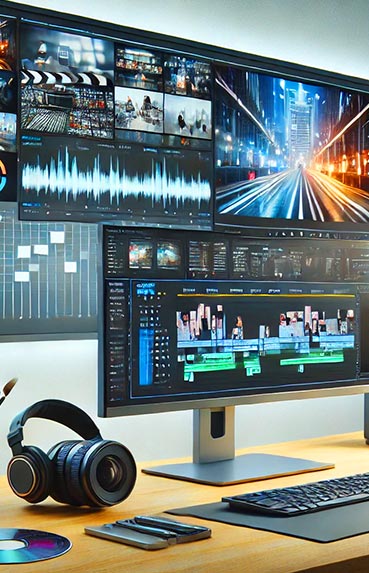In today's digital era, online video has become a powerful tool for communication, education, and entertainment. With the rise of platforms like YouTube, TikTok, and Vimeo, video trends are rapidly evolving, offering creators and businesses unique opportunities to connect with their audiences. In this article, we'll explore the most relevant online video trends you should follow to stay ahead in this dynamic medium.
The Popularity of Live Video
Live video has revolutionized the way brands and individuals interact with their audiences. It offers an authentic, real-time way to connect with viewers, creating a sense of community and urgency.
Advantages of Live Video
Real-Time Interaction: Live videos allow direct communication with the audience. Platforms like Facebook Live, Instagram Live, and YouTube Live facilitate Q&A sessions, where viewers can interact directly with hosts.
Authenticity: Live content can't be edited, adding a level of authenticity that viewers value. This authenticity can strengthen audience trust and loyalty toward a brand or creator.
Extended Reach: Social media algorithms often prioritize live content, increasing visibility and reach. According to a Livestream report, 80% of users would rather watch a brand's live video than read a blog.
Tips for Effective Live Video
- Plan Your Broadcast: While live video is spontaneous, basic planning is essential. Decide on the topic, structure, and duration before starting.
- Promote in Advance: Announce your live broadcasts in advance to build anticipation among your followers.
- Engage with the Audience: Respond to comments and questions in real time to encourage participation.
Short-Form Videos
The rise of platforms like TikTok and Instagram Reels has popularized short-form videos. These videos, typically lasting between 15 and 60 seconds, are ideal for quickly capturing attention in an information-saturated world.
Why Short Videos Work
Quick Consumption: In an environment where user attention is limited, short videos are easy to consume and can effectively convey messages in just a few seconds.
Easy to Share: Their brevity makes them ideal for sharing on social media, increasing the likelihood of going viral.
Creativity and Fun: Time constraints encourage creativity, pushing creators to be ingenious with their content.
Strategies for Creating Short Videos
- Focus on a Clear Message: Every second counts, so ensure your message is concise and direct.
- Utilize Trends: Leverage current trends and viral challenges to increase the relevance of your videos.
- Add Attractive Visual Elements: Visual and sound effects can enhance your video's quality and capture viewer attention.
Educational Content and Tutorials
Educational videos and tutorials are an effective way to provide value to your audience while establishing authority in your field. Platforms like YouTube have proven to be an inexhaustible source of self-directed learning.
Benefits of Educational Content
Builds Trust and Authority: Providing useful and educational information helps build a reputation as an expert in your area.
High Engagement: Users tend to spend more time consuming content that offers tangible value, resulting in longer viewing times.
Improved SEO: Educational videos are often rich in keywords, which can improve search engine rankings and increase organic traffic.
How to Create Successful Educational Videos
- Identify Your Audience's Needs: Understand what type of information your audience is looking for and how you can effectively provide it.
- Clear Structure: Ensure the content is well-organized and easy to follow.
- Incorporate Visual Elements: Use graphics, presentations, or demonstrations to complement your explanation.
The demand for online educational content has grown by 400% in recent years, according to a study by Think with Google.
Augmented Reality (AR) and Virtual Reality (VR)
Augmented reality and virtual reality technology are transforming the online video experience, offering immersive experiences that capture viewer attention in innovative ways.
Applications of AR and VR in Video
Immersive Experiences: AR and VR allow viewers to interact with content in a three-dimensional way, creating immersive experiences that boost engagement.
Interactive Storytelling: Stories told through AR and VR can be more impactful and memorable, allowing viewers to explore and participate in the narrative.
Education and Training: These technologies are particularly useful in sectors like education and training, where they can simulate environments and situations for practical learning.
Tips for Implementing AR and VR
- Start with Small Projects: If you're new to AR and VR, start with small projects to familiarize yourself with the technology.
- Collaborate with Experts: Work with AR and VR developers to ensure effective and professional implementation.
- Evaluate ROI: Since these technologies can be costly, it's important to assess the return on investment to ensure it's worth the expenditure.
Content Personalization
Video content personalization is a growing trend, as consumers seek experiences tailored to their individual preferences.
Why Personalization is Key
Enhances User Experience: Personalized content makes viewers feel valued and understood, which can improve satisfaction and loyalty.
Increases Relevance: By tailoring content to individual preferences, brands can increase the relevance and effectiveness of their message.
Boosts Conversion Rates: Personalization can lead to higher conversion rates, as content is tailored to the user's specific needs.
Personalization Strategies
- Use User Data: Collect and analyze user data to create detailed profiles and personalize content according to their preferences.
- Implement Recommendation Algorithms: Like Netflix or Spotify, use algorithms to suggest relevant content to each user.
- Create Interactive Content: Allow users to choose their own path in the video, selecting what to watch or how to interact with the content.
The world of online video is constantly evolving, driven by technological innovations and changing consumer preferences. By following these trends, you can ensure your content is not only relevant and engaging but also stands out in an increasingly competitive digital landscape.

















